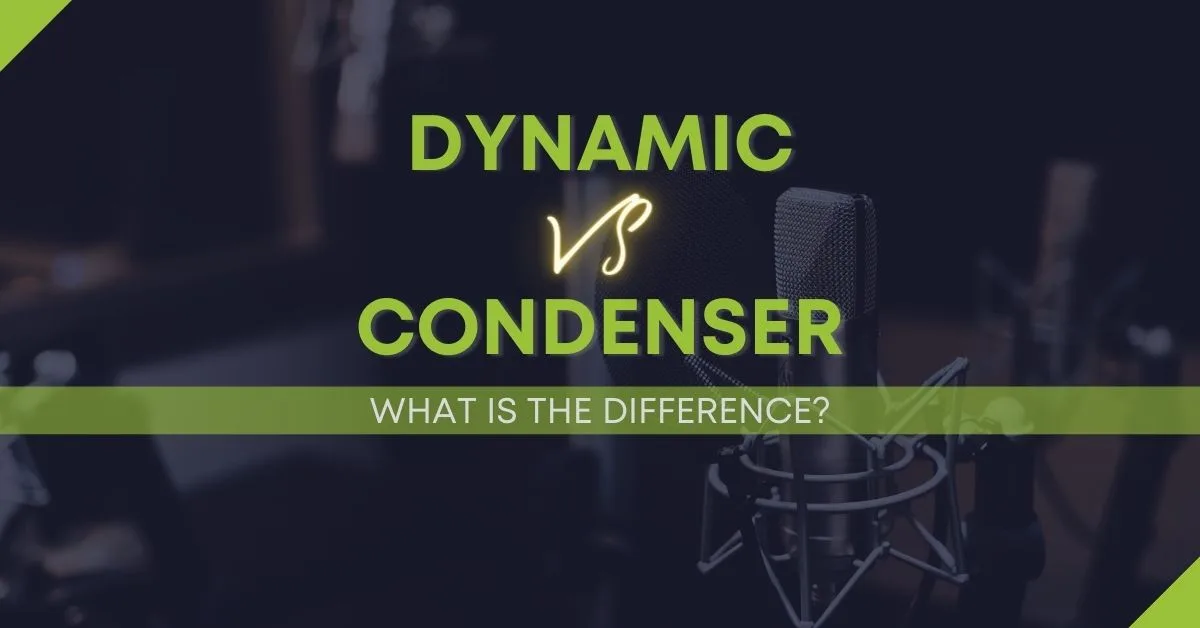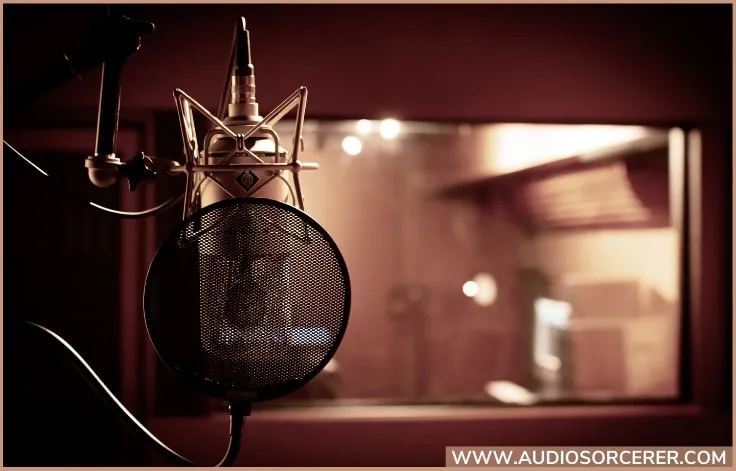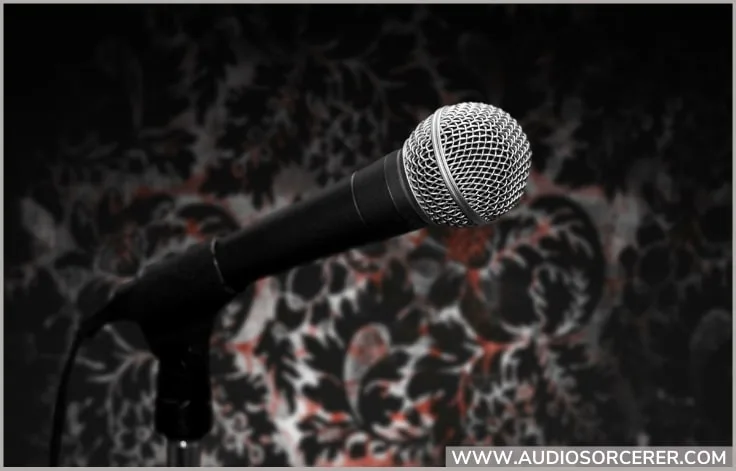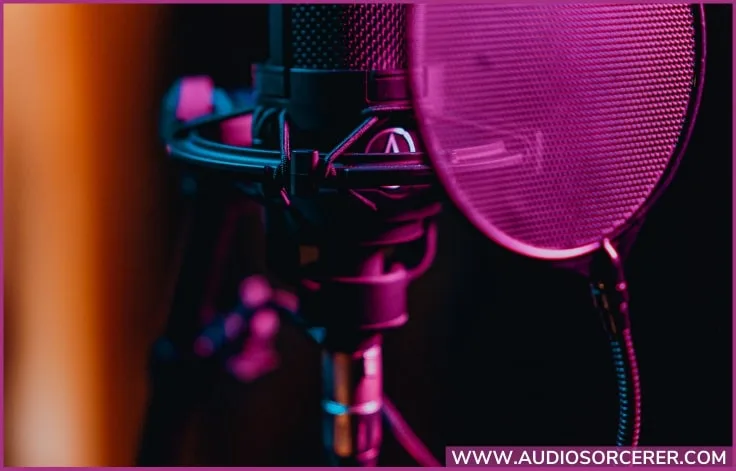
Microphones are the most important recording devices, whether you’re a professional or an aspiring musician. Mics help to capture the essence of a voice or instrument so it can be played back to the world. A good microphone can make all the difference in bringing out an amazing performance.
In the topic of dynamic vs condenser microphones there is a lot to discuss. If you want to create ultimate quality in your recordings, you need the right mic. Dynamic and condenser microphones are two of the most popular categories of microphones within the world of sound recording.
While dynamic microphones are more often used, what is the difference between the two? Is it necessary to have both?

As a general rule of thumb, condensers are better suited for recording studio vocals, while dynamic microphones are better for recording loud, strong sounds in a live setting. A dynamic microphone does not require external power, in contrast to a condenser microphone, which requires 48v phantom power.
The dynamic microphone and condenser microphone use different methods of electrical amplification to create a signal within the microphone’s diaphragm. Condenser microphones are sensitive to changes in temperature, humidity, pressure, and even small magnetic fields. This allows them to record at lower volumes than dynamic microphones. Overall, both types of microphones carry advantages and disadvantages when it comes to recording music.
In this dynamic vs condenser microphone blog post, lets take a look at some of their differences and what makes them suitable for certain tasks.
How Does A Microphone Work?

A microphone is a transducer. It converts sound waves into electrical signals. The microphone is made up of two parts: the diaphragm and the magnetic field. A small part of the magnetic field is used to produce an electrical signal.
The diaphragm is a very thin, flexible membrane that vibrates when sound waves strike it. Sound pressure increases as sound waves approach or move away from the diaphragm, causing it to vibrate. As the diaphragm moves back and forth in response to these vibrations, it creates a moving magnetic field that generates an electrical signal that can be amplified and recorded by an audio device.
Electrical signals are then sent through cables and wires to a device called an amplifier (or processor). Amplifiers convert these electrical signals into sound waves that you hear through speakers or headphones.
The 3 Main Types Of Microphone Diaphragms
We can’t talk about dynamic vs condenser microphones without first discussing what a diaphragm is. The diaphragm of a microphone is a thin membrane that moves in response to changes in sound pressure (sound waves). A microphone’s diaphragm is an essential component. As a transducer, a microphone would not be able to work without a diaphragm that moves. To convert sound pressure into electrical energy, the diaphragm must move in tandem with the sound waves.
We perceive a microphone diaphragm to have only two sides because it is so paper-thin. The diaphragm’s movement is determined by the difference in sound pressure on either side of it.
As part of microphones, the capsule contains the microphone diaphragm and other components that are used to collect sound. A microphones performance is heavily dependent on the design of the capsule. In every microphone, the transducer element that plays the most important role is the capsule.
Much of a microphone’s sound can be attributed to its capsule and diaphragm configuration. Capsule and diaphragm design substantially influence several aspects, including frequency response, sensitivity, and polar pattern.
There are mainly three types of microphone diaphragms:
- Moving Coil Diaphragm (dynamic microphone)
- Ribbon Diaphragm (dynamic microphone)
- Front Plate Diaphragm (condenser microphone)
Let’s see each of them in detail below.
1. Moving Coil Diaphragm

The moving-coil diaphragm consists of two distinct components: the diaphragm itself and the moving coil. It is convenient to conceive of them as a single moving component because they’re coupled together.
An external sound wave induces vibrations in the diaphragm/conductive coil assembly. It is the diaphragm’s job to be as responsive as possible to differences in air pressure on each side of it. When the conductive coil receives this vibration, it transforms it into a digital audio stream. An electromagnetic induction transducer is built inside the moving-coil diaphragm and the capsule.
Moving-coil diaphragms are almost always circular and firmly stretched within the microphone capsule around a stationary ring. Diaphragm sensitivity to sound waves is greatly influenced by tension.
The coil is typically half the diameter of the diaphragm in a common configuration. Diaphragm corrugation is caused by the union of these two parts. As a result, the diaphragm isn’t flat as a pancake. The diaphragm may also have small slits carved out of it for additional corrugation to increase its function by resolving intrinsic faults with the diaphragm and capsule construction.
2. Ribbon Diaphragm

There’s no doubt that the ribbon diaphragm is the most intriguing sort of diaphragm. Diaphragms that are linked to their capsule just on one side of their length are known as ribbon diaphragms. When compared to moving-coil and condenser diaphragms, they have a lower tension and are more commonly corrugated.
As a result, ribbon mics are also dynamic. Ribbon microphones use the same electromagnetic concept as moving-coil microphones. When sound pressure is applied to the back and front of the ribbon, the ribbon responds by moving, rather than having a separate diaphragm and conductive component fused. Electromagnetic induction provides an audio signal as the diaphragm travels around the ribbon.
3. Front Plate Diaphragm

The front plate diaphragm is a type of condenser microphone.
This type of diaphragm is the most common and widely used in microphones. It has a front plate, which houses the voice coil and magnet assembly. The voice coil is suspended from a voice coil former, which has two magnets that move along it to create an electrical current when it moves. This current then flows through an external cable that connects to a microphone preamplifier or amplifier.
What Is The Difference Between A Condenser And Dynamic Microphone?
The most common types of microphones are dynamic and condenser. The difference between these two can be difficult to understand, especially if you’re new to recording or just need a refresher on how to use them. There are also some differences in their price range, but the differences between them are more than just price. Lets now go in-depth about these differences in this dynamic vs condenser microphone post.
Dynamic Microphone vs Condenser Microphone
Dynamic microphones are typically less expensive than condenser microphones. This makes them good for beginners who want to get started without spending a lot of money. They also do not require phantom power as most condensers do. Dynamic mics are also great for handling instruments with high levels of sound.
Condenser microphones are more versatile than dynamic mics as they can have multiple polar patterns. The sound can be as narrow as cardioid to as wide as omni. These mics also have better low-end response and sensitivity than dynamic mics do. The closer you get to them the more the “proximity effect” will be apparent. It is important to note that condenser mics do tend to be more expensive than dynamic mics.
In these following bullet points, we’ll go through the differences of dynamic vs condenser microphones.
- A dynamic mic’s frequency response is usually restricted and skewed, whereas a condenser mic’s response is extremely accurate yet sterile sounding.
- A dynamic microphone’s transducer principle differs significantly from a condenser microphone’s. Condenser microphones use electrostatic principles to transfer energy, whereas dynamic microphones use electromagnetic induction.
- Because electricity is required for effective operation, every condenser microphone is considered to be an active device. Passive microphones don’t need any external power to conduct their job, and dynamic microphones fall under this category.
- As far as polar patterns are concerned, the condenser microphone design makes it simple to obtain any polar pattern and even to construct microphones with several polar pattern possibilities. However, dynamic microphones can only have one polar pattern and cannot be bidirectional due to their construction.
- Durability is critical while traveling with microphones or when using any microphone under less-than-ideal conditions (extreme weather, temperature, and humidity, as well as in physically demanding or rough applications). Even though condenser mics are known for their long-term reliability, dynamic microphones are the industry standard when it comes to robust quality.
- Condenser microphones are often much more sensitive than dynamic microphones, which means they pick up more sound. Dynamic microphones are usually better suited for live recording and speech applications, while condenser mics tend to be best suited for recording instruments or vocals in a studio setting.
When purchasing and utilizing a dynamic vs condenser microphone, price and budget are always important considerations. The price range for condenser microphones is much more broad than dynamic microphones.
Related Article: Stellar X2 Vintage Review | Is This The Best Mic Under $300?
When Should You Use A Dynamic Microphone?

Dynamic microphones are the most common type of microphone used by musicians and singers for live performances. They are designed to capture sound at the source and need to be much closer to it than a condenser microphone. As much as they shine in the live environment they play just as much a role in studio recording. Lets now dive into their use cases.
Live Performance
Dynamic microphones are best for live performance, as they can handle the loud volume and provide a clear sound. They are also easy to set up and use.
With Drums
Dynamic microphones are more commonly used in the recording of drums. They are used to capture the sound of the drum set in a way that is free of distortion, noise, or echo. The drum kit is one of the loudest instruments out there and dynamic mics are the best choice to handle the amplitude.
With Brass
Dynamic mics are often used with brass instruments, like trombones and trumpets. Since they are very directional this helps them block out other sounds. It’s not uncommon for brass instruments to be recorded in an environment where there are loud noises around. This can be a live concert or recording session.
With Guitar
Dynamic mics are a great choice for recording acoustic instruments, like guitars. They pick up the sound of the instrument’s body and headstock, while the mic itself doesn’t add any noticeable coloration to the sound.
This can make them ideal for recording live tracks where you want to capture the true character of your performance. They can be more forgiving than condenser mics, which may produce unwanted sounds if you don’t position them right or use a shock mount correctly.
Dynamic mics are also ideal for micing up amp cabinets.
When Should You Use A Condenser Microphone?

A condenser microphone is a device that converts an electrical signal into a mechanical one. In other words, it converts electricity into sound. The most common use of a condenser mic is in recording studios to capture the best quality sound from instruments and voice. Other uses include Zoom calls, podcasts, and live streaming.
Studio Voice Recording
Condenser microphones are best suited for studio recording. Large-diaphragm condenser microphones are more suitable for studio applications than small-diaphragm condenser microphones because they have better frequency responses at high frequencies than their counterparts. They are also more sensitive to high sound pressure levels than small-diaphragm mics, so they can be used at higher SPL levels without distorting the recorded audio signal.
For Voiceovers
Condenser microphones are preferred for voiceovers, as they have a much higher sensitivity and pick up more of the main frequency of the voice while rejecting unwanted noise. This makes them ideal for recording narration and voiceover work.
Consumer Devices
Condenser microphones are typically used in consumer devices such as digital recorders, smartphones, and computers. These devices require a microphone that can pick up sound from a distance. The sound quality must be clear and crisp as these are devices we use in our everyday life.
Which Microphone Is Right For Me?
Microphone choice is one of the most important decisions in recording and production. You need to make sure that you get the right microphone for the job, whether you’re recording live or in the studio.
It’s a common misconception that when comparing dynamic vs condenser microphones that condenser are better. The truth is that both types of these microphones have a place depending on your needs.
Pick the one that is best for your application or better yet… get one of each!
Final Thoughts
Although it is possible to utilize one microphone in place of another, it is helpful to be aware of the circumstances in which one microphone is preferable to another. Consider all of the aforementioned aspects, as well as where the microphone will be placed, the kind of space or venue it will be in, and the instruments that will be picked up by the microphone. Hopefully after reading this dynamic vs condenser microphone article you can now pick the best microphone for you.
In addition, we are here to assist you in any way we can. Leave a comment below and we’ll help you get the most out of your equipment.
“Some of the links within this article are affiliate links. These links are from various companies such as Amazon. This means if you click on any of these links and purchase the item or service, I will receive an affiliate commission. This is at no cost to you and the money gets invested back into Audio Sorcerer LLC.”



